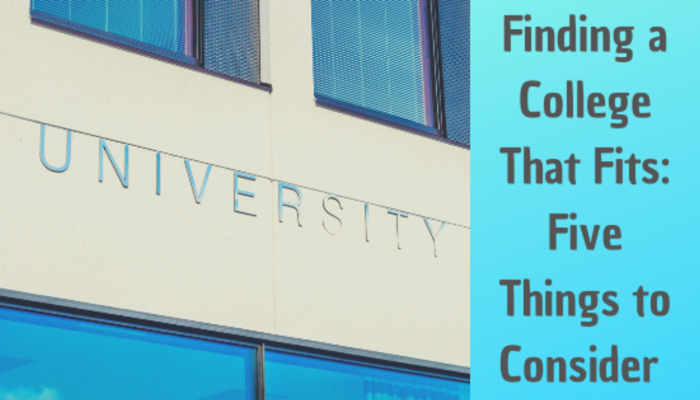Finding a College that Fits – Five Things to Consider
By Guest Blogger Lisa Witherspoon
My oldest daughter, a senior in high school, submitted college applications this fall. Now we are in the “waiting window” as we anticipate acceptances (or not) from all the schools to which she applied. The process was an eye-opening one for me because it is so VERY different from when I applied about twenty-five years ago.
One of the first steps in the process was choosing which colleges she would actually apply to. According to the National Center for Education Statistics, there were 4,298 degree-granting postsecondary institutions in the U.S. as of the 2017-2018 school year. Some entities would offer an even higher number due to universities with satellite campuses and other factors. Needless to say, narrowing down our options was a little daunting. This is a process that really starts early in high school.
Here are some things I learned and some things you might consider when you are helping your child narrow down the list:
Does your son/daughter know their intended major? Teens feel a lot of pressure to decide on a major early in high school. (At least my daughter did!) At first, I thought this was ridiculous. Then, I realized it can really have a big impact on the college application process. For example, my daughter wanted to major in architecture, but not every university offers that major, so our list was immediately scaled down. The same might be true if your child is thinking about a specialized program like engineering, film, or nursing. Also, some universities require you to apply directly to their school of architecture/engineering/etc. when you submit your initial application. Most schools require applicants to indicate an anticipated major or anticipated school of focus on their Common or Coalition Application. That intention may or may not have any bearing on their acceptance, depending on the school. Also, some schools make changing majors difficult or impossible (depending on the major) and some make it easier. On the flip side, most schools allow students to declare “undecided” and offer programs to assist first year students in making a decision. If your teen is unsure of a target concentration, this could also have an impact on the schools you choose.
Where is the university located? The answer to this question can include everything from climate to urban vs. rural setting to actual distance from home. Does your teen mind the bitter cold of mountain or northeast schools? Does he/she prefer an urban, big city setting or find that overwhelming? If they go to a school that is far away, are you willing to pay air fare every time they want to come home and how often do they think they will want to come home? Mostly, these are all a matter of personal preference, but certainly something to consider that can help narrow the field.
Does your child prefer a larger or smaller school? Again, this is personal preference, but is a factor that can help whittle down the choices. Does your teen prefer a smaller setting where classes are smaller and the campus is compact? Or does he/she lean toward a larger crowd with more activities and social options? Is he/she adept at finding their own social niche in a big group? Does he/she need close connections with professors and a strong sense of community?
What is the overall vibe of the college? This one is important, but difficult to determine. Some universities are hard core academic institutions focused on engineering, medicine, and law. Others are intensely liberal arts schools whose backbone is art, dance, and music. Some colleges seem more laid back while others seem more haughty and formal. Of course, there are also single gender schools, religiously affiliated schools, and schools with a huge focus on athletics and school spirit. What kind of atmosphere is your child looking for?
How much will it cost? A school’s tuition and your personal financial situation is definitely something to consider, but not as important as you might think. Most schools offer some scholarships and all college applicants must submit the FAFSA (Free Application for Federal Student Aid). In general, though, you won’t know what financial aid is being offered until you receive acceptances in the spring of your child’s senior year. There are lots of other scholarships available as well that are based on anything from academic performance, to athletics, to race/ethnicity, to intended major. If your child is interested in a school that is out of your price range, my advice is to let him/her apply, but have an honest conversation about the financial aid needed to make it a feasible option if they are accepted.
As soon as your teen begins narrowing his/her list, it is vitally important to start visiting some schools. Pretty much all schools offer information sessions and guided tours. While these are often “scripted,” they can give you lots of information about the school’s atmosphere, student life on campus, and any application process details specific to that school. These visits, however, take some planning (especially if they are not close to home), so start early!
Finally, the big question – just how many schools should your teen actually apply to? Unfortunately, there is no set answer to this question. My daughter’s guidance counselor recommended choosing at least three – a reach school (one they have a slim chance of getting into), a realistic school (one they are likely to get in to and can probably afford), and a safety school (one they are almost sure to get in to and is a viable financial option with no aid.) However, I have read other articles that recommend applying to 2-3 reach schools, 2-3 safety, and 3-4 realistic ones. My daughter has friends who applied to only one (because they were guaranteed acceptance due to athletics), friends who applied to nearly twenty, and many friends who are somewhere in between. In the end, this is a very individual decision. Three things to consider:
1) Time – including time to visit schools, fill out applications and supplemental essays, etc., and timing of your applications (i.e Early Decision/Action vs. Regular Decision)
2) Money – each application you submit incurs an application fee averaging $65-$85 each. The more you apply to, obviously, the more it costs – whether you are accepted or not
3) Selectiveness of chosen schools – in general, the more competitive the schools are, the more you should apply to. You can easily Google a school’s acceptance rate – schools like Harvard are around 5% while there are some little-known schools that actually have a 100% acceptance rate!
As you begin the college selection process with your teen, it can be easy to become overwhelmed. Give yourself (and your teen) plenty of time to do the due diligence of researching options, seek help from professionals or other parents who have been through it, and, most of all, remember to breathe!
For more blogs related to High School and College, click here. Want to see more blogs like this and get notifications on local events and happenings? Subscribe to Triad Moms on Main’s free weekly newsletters here.






